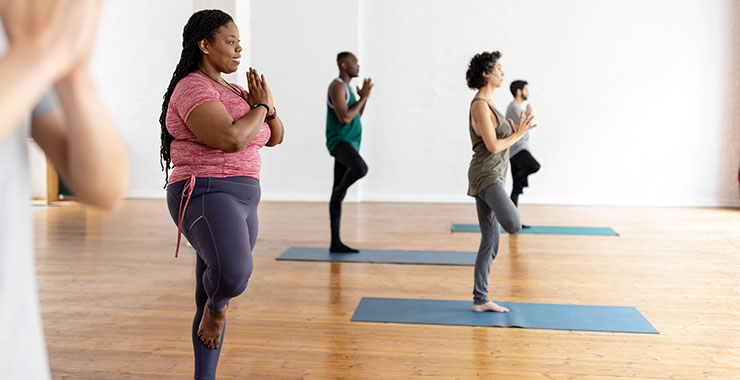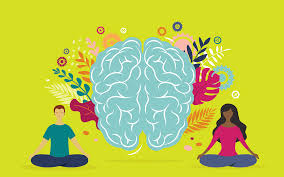The Benefits Of Yoga For Managing Depression

The sun is barely peeking above the horizon, and the stillness of the morning air is broken only by the sound of birds chirping in the distance. One person stands atop a grassy hill, with their bare feet planted firmly on the ground. Their eyes are closed as they take their first deep breath of the day, starting their journey into an ancient practice that has been around for centuries: yoga.
Yoga has been used for many years to help people manage depression and improve their overall wellbeing. In this article, we will explore how yoga can benefit those suffering from depression in order to help them find inner peace and balance in their lives.
Depression is a serious mental illness that affects millions of people across the world. It can be difficult to cope with and often leads to feelings of hopelessness, guilt, and sadness. Fortunately, there are many ways to cope with depression; one such way is through regular practice of yoga. Yoga can provide physical, emotional, mental and spiritual benefits that can help manage symptoms associated with depression like anxiety or stress.
Yoga encourages mindfulness which helps us become more aware of our bodies’ needs and reactions in order to understand our emotions better. Through various poses and breathing exercises, yoga increases strength and flexibility while also reducing stress levels as well as calming an overactive mind – all important aspects for managing depression effectively. In this article we will look further into how yoga can be beneficial in managing depression so that readers may gain insight into how they could use it as part of their own self-care routine.
Definition of Yoga
Yoga is a physical, mental, and spiritual practice that originated in India. It involves various postures and breathing techniques designed to bring balance and harmony to the body and mind. Yoga has been used for centuries to help people cope with depression, anxiety, and other mental health issues.
The practice of yoga can help manage depression by reducing stress levels, improving moods, and providing an outlet for emotional release. It can also increase self-awareness, enabling one to better understand their feelings and emotions. Additionally, it improves overall physical health by strengthening muscles and increasing flexibility. All these factors contribute to improved mental health.
Types Of Yoga
Yoga is a diverse practice, with many different styles and techniques. Each type of yoga offers unique benefits for managing depression. Hatha yoga, for example, is a gentle practice that combines physical postures with breathing exercises and meditation. It can help reduce stress and anxiety while increasing relaxation and well-being.
Vinyasa yoga is another popular form of yoga that focuses on connecting the breath to movement. This style of yoga can help foster mindfulness, which has been linked to improved mental health. Restorative yoga is also beneficial for those looking to manage their depression, as it involves slower poses held for longer periods of time. By calming the body and mind, this style of yoga can help bring about a sense of peace and contentment.
Yoga can be an effective practice for managing depression when tailored to the individual’s needs and preferences. Whether someone chooses hatha, vinyasa or restorative yoga, they will likely experience greater levels of calmness and well-being from their practice. With regular practice, these feelings are likely to increase further over time – providing an invaluable tool in managing depression symptoms.
Mindful Breathing Exercises
Mindful breathing exercises can be an effective tool for managing depression. Practicing deep, mindful breathing can help to calm the mind and body, creating a sense of peace. This practice can be done anywhere and doesn’t require any special equipment. It is important to focus on breathing slowly and deeply into the stomach, rather than just the chest. Taking slow breaths in through the nose and out through the mouth helps to relax the body.
Mindful breathing can also be used as a way to become more aware of negative thoughts or emotions that arise during moments of distress. By noticing these thoughts or emotions without judgment, it is possible to observe them with an open mind, allowing them to pass away naturally instead of escalating into something more powerful. This awareness helps one become more aware of their own emotional state, providing insight into how certain situations affect them and allowing for better self-management in difficult moments.
Stress Relief Techniques
Yoga is one of the most effective stress relief techniques for managing depression. It helps to reduce cortisol levels, which are associated with increased stress and anxiety. Through engaging in some simple yoga poses, you can relax your body and quiet your mind, allowing you to gain control over your thoughts and feelings. Additionally, yoga encourages mindfulness and awareness, helping you to become aware of how your thoughts and emotions can influence the way you approach life.
Along with yoga, guided relaxation exercises are also beneficial for reducing stress levels. These exercises involve focusing on slow breathing and releasing tension from the body through progressive muscle relaxation. This helps to slow down the heart rate and regulate breathing, which can help reduce symptoms of depression such as insomnia or difficulty concentrating. Furthermore, it provides a calming effect that can help clear away any anxious or negative thought patterns that may be contributing to depression.
Increased Self-Awareness & Compassion
Moreover, yoga can help to cultivate increased self-awareness and compassion. Through a regular practice of yoga, individuals are able to gain greater insight into their thoughts, feelings, emotions, and physical sensations. This can lead to improved self-understanding and understanding of others.
Practicing yoga can also help to increase one’s level of compassion and empathy towards themselves and others. By calming the mind and body through breathing techniques, mindfulness exercises, and postures, yoga helps to create a space for individuals to be compassionate with their innermost thoughts and feelings.
This in turn leads to greater understanding of the needs of others as well as the ability to respond with more compassion in difficult situations. Furthermore, practicing yoga can help people better understand how they communicate with others and how they interact in relationships. By becoming aware of how stress or anxiety can manifest physically or emotionally in our bodies, we become more mindful in our interactions with others. Ultimately, this allows us to foster healthy relationships that are based on mutual understanding and respect.
Improved Mood Regulation
Yoga has been found to be an incredibly effective tool for managing depression and mood regulation. Through regular practice, yoga helps to reduce levels of stress hormones in the body while increasing production of endorphins. This allows individuals to experience a sense of inner peace, which can be incredibly beneficial when dealing with depression.
Additionally, by teaching users how to stay present and mindful, yoga can provide a much-needed respite from rumination and obsessive thinking patterns that are often associated with depression. The breathing techniques taught in yoga classes can also help practitioners become more aware of their emotions and feelings and learn how to better process them. Ultimately, these skills can be used to break the cycle of negative thinking associated with depression.
Better Sleep Quality
Studies have shown that regular yoga practice is associated with a 65% improvement in sleep quality. As such, it can be an effective therapy for managing depression, which is often caused by insomnia and other challenges related to poor sleep.
Yoga helps reduce stress and anxiety, which are both major factors contributing to insomnia. It also increases the body’s relaxation response, allowing the mind and body to rest more easily. Additionally, yoga can help regulate cortisol levels, a hormone responsible for controlling our body’s internal clock. This can lead to improved sleep patterns and better quality of sleep overall.
By practicing specific poses and breathing techniques before bedtime, individuals suffering from depression can enjoy better restorative sleep on a regular basis. And this improved sleep can have lasting effects on overall mental health and wellbeing.
Muscle Relaxation & Flexibility
Yoga can be used to increase muscle relaxation and flexibility. The physical movements of yoga help to relax the muscles. This is beneficial for people suffering from depression because it can reduce tension and stress in the body. Additionally, yoga helps to improve posture and balance which increases self-confidence as well as physical strength.
By increasing muscle flexibility, yoga also helps to reduce pain. Tight muscles cause discomfort and pain. People who practice yoga regularly are able to stretch their muscles, resulting in improved range of motion and less pain. Yoga also helps with breathing exercises that deepen breathing patterns, which decreases stress levels and promotes relaxation. Overall, these physical benefits help manage depression symptoms by reducing anxiety, improving sleep, and increasing positive moods.
Regulated Blood Pressure & Heart Rate
In addition to its muscle relaxation and flexibility benefits, yoga can also help regulate blood pressure and heart rate. This is mostly due to the influence of deep breathing exercises on the body. The rhythmic breathing exercises in yoga work to reduce stress hormones in the body and promote feelings of calmness.
Yoga can also have a positive impact on your cardiovascular health by:
- Increasing oxygen levels in the body
- Enhancing circulation
- Reducing inflammation
- Helping lower blood pressure
The combination of these physical benefits can help create an overall sense of wellbeing, which may help ease depression symptoms. The mental clarity that comes with a regular practice of yoga can lead to increased awareness, improved concentration and more meaningful connections with others. Furthermore, the physical activity itself releases endorphins, which are natural mood enhancers that can help reduce stress and anxiety.
Decreased Anxiety
Yoga’s calming and relaxing effects can help to reduce anxiety. The physical poses, controlled breathing, and meditation increase the body’s ability to relax, which in turn reduces anxiety levels. Studies have found that regular yoga practice increases serotonin and GABA levels, two neurotransmitters that are linked to reduced symptoms of anxiety. Additionally, the mindfulness elements of yoga can help people become more aware of their thoughts and feelings, allowing them to better recognize anxious patterns and respond in a healthier way.
The focus on the breath during yoga helps regulate breathing patterns that may be disrupted due to stress or anxiety. Improved breathing helps increase oxygen intake which then helps reduce tension in both the body and mind. Taking slow deep breaths is a key part of many yoga practices – this has an immediate calming effect on the body’s nervous system, helping to reduce anxiety levels.
It also gives practitioners an opportunity to practice self-expression through movement while focusing on their breath – providing an outlet for any unpleasant emotions they may be experiencing due to depression or anxiety.
Improved Concentration & Memory
Recent studies have shown that just 8 weeks of regular yoga practice can significantly increase concentration and memory. This was demonstrated in a controlled experiment where the participants experienced improved performance on tests of attention, concentration and recall. This is great news for those looking to combat depression and its associated issues.
Yoga has been found to be effective in reducing stress, which can play a role in cognitive decline. Stress disrupts the body’s natural balance, causing us to become overwhelmed with negative emotions and suffer from poor mental clarity. By engaging in regular yoga sessions, we can begin to counteract these effects and restore our sense of peace and clarity. Additionally, yoga postures help improve circulation throughout the body, including to the brain, which helps provide more oxygen for better cognitive function. Furthermore, it increases the levels of neurotransmitters like serotonin and dopamine which are essential for good mental health.
The combination of stress relief and improved circulation helps individuals focus better while also improving their overall moods. In turn this leads to increased energy levels and improved motivation – both of which are essential when dealing with depression.
How To Get Started With Yoga
Now that we have discussed the benefits of yoga for improved concentration and memory, let’s look at how to get started with yoga. First and foremost, it is important to understand your own physical capabilities and limitations. Before beginning any form of yoga practice, consult a doctor and consider taking a beginner’s class to learn the basics. This will help ensure that you are doing the poses correctly and safely.
Once you have established your baseline understanding of yoga, try exploring various styles of practice. Hatha Yoga is great for beginners as it focuses on proper alignment in poses while incorporating breathing techniques throughout each pose. Vinyasa Yoga is another popular style that focuses on connecting movement with breath for a flowing sequence of poses. It is important to find something that resonates with you so that you can make yoga part of your daily routine.
Safety Guidelines For Practicing Yoga With Depression
When practicing yoga for depression, safety should be the primary concern. Knowing your physical limitations and following guidelines can help ensure a safe practice. It’s important to take it slow and start with simple poses that are comfortable for you. If any pose causes pain or discomfort, stop the pose immediately. If you feel dizzy or lightheaded, come out of the pose and rest in child’s pose until you feel better.
It’s also important to remember that all forms of physical activity will increase your heart rate. Therefore, it is essential to listen to your body and stay mindful of how you’re feeling while practicing yoga. Don’t push yourself too hard or beyond what feels comfortable. Remember that everyone’s practice is unique, so don’t compare yourself to others and find the right pace for yourself.
Frequently Asked Questions
How Long Does It Take To See The Benefits Of Yoga For Managing Depression?
Yoga has long been used for its therapeutic benefits, and it can be especially effective in managing depression. But how long does it take to start seeing the positive effects of yoga?
The answer depends on many factors, including the severity of the depression, how often one practices, and whether they are combining yoga with other therapies such as counseling or medication.
Here are some signs that yoga is helping manage depression:
- Improved sleep quality
- Increased energy levels
- Greater emotional balance and resilience
- Decreased feelings of loneliness or isolation
- Heightened self-awareness and self-esteem
It’s important to understand that everyone experiences depression differently. So while some people may see results right away, others may need more time before they begin to feel the impact of yoga on their mental health. The key is to remain consistent with your practice and be patient with yourself as you integrate yoga into your life.
Is It Safe To Practice Yoga If I Am Taking Medication For Depression?
Yoga can be an effective tool for reducing symptoms of depression, but is it safe to practice if you’re already taking medication? This is a valid question, as mixing certain types of medication with yoga poses may cause unwanted side effects.
The answer depends on the type of medication you are taking and what type of yoga poses you’ll be practicing. Certain medications, such as tranquilizers or anti-depressants, can interact with specific poses or breathing exercises. It’s important to check with your doctor before starting any new exercise regimen. Here are four tips to keep in mind:
- Speak with your doctor about the benefits and risks associated with combining yoga and medication
- Follow all instructions from your doctor regarding dosage, timing and type of yoga practices
- Start slowly, using gentle stretches and poses that don’t require much exertion
- Listen carefully to your body; if something feels uncomfortable, stop immediately and contact your doctor
If managed safely and correctly, yoga can help reduce symptoms of depression while also providing other physical benefits such as decreased stress levels and improved flexibility. With this in mind, it’s essential to take extra precaution when combining yoga with medication for depression. Taking steps like speaking with your doctor beforehand will help ensure that you experience the full benefits without putting yourself at risk.
Is It Necessary To Attend Yoga Classes Or Can I Practice Yoga At Home?
Attending yoga classes or practicing yoga at home are both viable options when it comes to incorporating an effective yoga routine into your life. It’s important to consider the pros and cons of each option in order to determine which one works best for you.
Yoga classes offer a sense of structure and accountability that can be beneficial for those who have difficulty sticking with a practice. Many studios also provide personalized instruction, as well as props and modifications that can help make the practice more enjoyable. Additionally, attending classes is a great way to meet like minded people, build relationships, and find support from your peers.
On the other hand, practicing yoga at home can be convenient, cost-effective, and allows individuals to work at their own pace. Home practice also provides more flexibility in terms of scheduling since you don’t need to worry about fitting your practice into someone else’s schedule. Furthermore, it gives you the opportunity to explore different kinds of yoga without having to worry about keeping up with others in a class setting.
Whichever route you choose, remember that consistency is key when it comes to reaping the full benefits of yoga. Taking time out of each day or week to focus on your breath and movement can have profound effects on both physical and mental health. The important thing is finding what works best for you so that you can make the most out of your practice!
Are There Any Particular Poses That Are Especially Beneficial For Managing Depression?
Did you know that nearly 17 million adults in the US suffer from depression each year? With so many people struggling with this mental health issue, it’s no surprise that many are turning to yoga as a way to manage their depression. But are there any particular poses that are especially beneficial for managing depression? Let’s explore how yoga can help.
Yoga is believed to be one of the most effective ways of treating depression because of its focus on stretching and strengthening the body, as well as calming and focusing the mind. It can also increase blood flow to the brain, which helps reduce stress and anxiety levels. Certain poses, such as forward bends and inversions, can be particularly helpful for managing depression due to their ability to relax tense muscles and release tension from the body. Additionally, warrior poses can help build strength and courage while seated meditation is great for reducing stress by calming the mind and releasing negative thoughts.
All of these poses work together to create a sense of balance within oneself; helping an individual feel more connected with their inner self and boosting overall mood. Furthermore, practicing yoga regularly can lead to positive changes in behavior by providing healthier coping skills when dealing with difficult situations or emotions. It’s important to note, however, that while yoga may be beneficial for managing depression it should not replace professional medical help if needed.
Are There Any Risks Associated With Practicing Yoga For Depression?
When it comes to managing depression, yoga is often presented as a beneficial practice. While there are numerous potential benefits, it’s important to consider the risks associated with practicing yoga for depression.
Yoga poses can be physically and mentally challenging, so it’s essential to ensure that any poses you attempt are appropriate for your skill level and physical abilities. If you’re new to yoga, consider attending classes taught by an experienced instructor who can provide guidance on proper form and alignment. Additionally, if you have any existing health conditions or injuries, make sure to inform your teacher before class begins.
Some people may experience mental side effects while practicing yoga, such as feelings of anxiety or fear. For those with a history of trauma or PTSD, certain poses or breathing exercises could trigger uncomfortable memories or emotions. Therefore, if these sensations arise during practice it’s important to take a break from the pose and modify the breathwork accordingly. Yoga should leave you feeling relaxed and rejuvenated – if this isn’t the case for you then seek help from a qualified professional.
Conclusion
In conclusion, yoga is a safe and beneficial way to manage depression. With regular practice, the benefits can be seen in as little as 8 weeks, so it’s important to stay committed. It is safe to practice yoga while taking medication for depression, but it is always important to consult your doctor first. You can practice yoga at home or in a class setting – whichever you prefer. There are certain poses that have been proven to be especially beneficial for managing depression, such as child’s pose and bridge pose. While there are no risks associated with practicing yoga for depression if done correctly, it is always best to seek guidance from a qualified instructor if you are new to the practice.
So why not give yoga a try? It could just be the answer you need for managing your depression!









